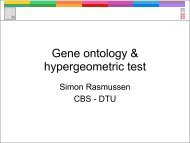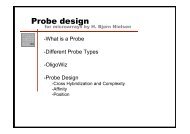Computational tools and Interoperability in Comparative ... - CBS
Computational tools and Interoperability in Comparative ... - CBS
Computational tools and Interoperability in Comparative ... - CBS
You also want an ePaper? Increase the reach of your titles
YUMPU automatically turns print PDFs into web optimized ePapers that Google loves.
short-cha<strong>in</strong> n-alkanes by A. borkumensis SK2 <strong>and</strong> AP1<br />
was experimentally proven (Smits et al., 2002; Hara et al.,<br />
2004; Sabirova et al., 2006). Interest<strong>in</strong>gly, the two regions<br />
compris<strong>in</strong>g of alkS, alkB1, alkG <strong>and</strong> aldH alkanedegradation<br />
genes <strong>and</strong> of alkB2 <strong>and</strong> transcriptional<br />
regulators, respectively (Table 1), are as similar to each<br />
other <strong>in</strong> their TU patterns (D = 34.3%) as each of them<br />
is to Yers<strong>in</strong>ia pestis (D = 32.2% for alkB1, D = 33.4%<br />
for alkB2), Yers<strong>in</strong>ia enterocolitica (D = 29.5% for alkB1,<br />
D = 34.4% for alkB2) <strong>and</strong> Shewanella oneidensis MR-1<br />
(D = 32.5% for alkB1, D = 42.4% for alkB2). This data<br />
suggests that the alkB1 <strong>and</strong> alkB2 genes were delivered<br />
to A. borkumensis from an ancestor of the Yers<strong>in</strong>ia<br />
l<strong>in</strong>eage. The AlkB1 am<strong>in</strong>o acid sequences of A. borkumensis<br />
stra<strong>in</strong>s AP1 <strong>and</strong> SK2 are highly homologous to<br />
that of P. putida stra<strong>in</strong>s P1 <strong>and</strong> GPO1 (van Beilen et al.,<br />
2001; 2004; Smits et al., 2002; Hara et al., 2004), but their<br />
TU patterns are not that similar (D = 37.1). Surpris<strong>in</strong>gly,<br />
the TU pattern of the alkB cluster of P. putida<br />
is significantly more similar with the global TU pattern of<br />
the whole A. borkumensis chromosome (16.7%, stra<strong>in</strong><br />
GPO1, 19%, stra<strong>in</strong> P1), but more distant from the<br />
P. putida KT2440 chromosome (30.1% <strong>and</strong> 30.3%).<br />
D-values of 17 or 19% are with<strong>in</strong> the first quartile (0–26%)<br />
far below the median value of 28.4% for local TU patterns<br />
of the A. borkumensis chromosome (Fig. 5) <strong>in</strong>dicat<strong>in</strong>g<br />
that. the P. putida alkB gene behaves as if it were part of<br />
the Alcanivorax core genome. We note the strik<strong>in</strong>g phenomenon<br />
that there was converg<strong>in</strong>g evolution of the<br />
cod<strong>in</strong>g sequence of the catabolic alk transposon <strong>in</strong><br />
Alkanivorax <strong>and</strong> Pseudomonas, but that the genes<br />
reta<strong>in</strong>ed the oligonucleotide signature of their donors,<br />
most likely Alkanivorax for Pseudomonas <strong>and</strong> Yers<strong>in</strong>ialike<br />
organisms for Alkanivorax.<br />
<strong>Comparative</strong> genomics of Alcanivorax borkumensis 7<br />
Orig<strong>in</strong> of replication<br />
The GC skew plotted <strong>in</strong> the seventh circle of the genome<br />
atlas (Fig. 1) reflects a general bias of pur<strong>in</strong>es towards the<br />
lead<strong>in</strong>g str<strong>and</strong> of DNA replication, however, it has almost<br />
no correlation to the structural properties of DNA<br />
(Skovgaard et al., 2002). The GC skew is often useful<br />
when locat<strong>in</strong>g the orig<strong>in</strong> <strong>and</strong> term<strong>in</strong>us of replication<br />
(Jensen et al., 1999).<br />
The circle is blue on the right side <strong>and</strong> purple on the left<br />
side. The two big gaps of colours <strong>in</strong> the top <strong>and</strong> <strong>in</strong> the<br />
bottom of the circle may be the orig<strong>in</strong> <strong>and</strong> the term<strong>in</strong>us of<br />
replication. This may also be visualized more clearly <strong>in</strong> the<br />
orig<strong>in</strong> plot (Fig. 6) (Worn<strong>in</strong>g et al., 2006). Here, the difference<br />
between hypothetical lead<strong>in</strong>g <strong>and</strong> lagg<strong>in</strong>g str<strong>and</strong> is<br />
plotted (red) for various positions on the chromosome.<br />
The peaks <strong>in</strong>dicat<strong>in</strong>g maximal oligonucleotide skew correspond<br />
to orig<strong>in</strong> <strong>and</strong> term<strong>in</strong>us. The term<strong>in</strong>us was identified<br />
as the peaks show<strong>in</strong>g low G/C weighted str<strong>and</strong> bias<br />
at 1 502 000 bp position. The orig<strong>in</strong> was identified as the<br />
other peak at 3 118 000 bp position. The signal to noise of<br />
14.0 was among the top 10% of sequenced Proteobacteria,<br />
<strong>in</strong>dicat<strong>in</strong>g a big difference between lead<strong>in</strong>g <strong>and</strong><br />
lagg<strong>in</strong>g str<strong>and</strong> mak<strong>in</strong>g the prediction of orig<strong>in</strong> very<br />
confident.<br />
Structural analysis of promoter regions<br />
Structural features of the genomic DNA may <strong>in</strong>dicate promoter<br />
regions, as promoters normally have high curvature,<br />
melt easily <strong>and</strong> are more rigid. The DNA structural<br />
parameters mentioned earlier (position preference, stack<strong>in</strong>g<br />
energy, <strong>and</strong> <strong>in</strong>tr<strong>in</strong>sic curvature) together with AT<br />
content <strong>and</strong> DNAse sensitivity (Brukner et al., 1995) were<br />
Fig. 6. Localization of the orig<strong>in</strong> <strong>and</strong> the<br />
term<strong>in</strong>us of replication <strong>in</strong> the A. borkumensis<br />
SK2 chromosome derived from str<strong>and</strong> bias<br />
curves: the median oligonucleotide skew<br />
curve (red), the GC weighted median (green)<br />
<strong>and</strong> the AT weighted median (blue) (Worn<strong>in</strong>g<br />
et al., 2006).<br />
©2007TheAuthors<br />
Journal compilation © 2007 Society for Applied Microbiology <strong>and</strong> Blackwell Publish<strong>in</strong>g Ltd, Environmental Microbiology









